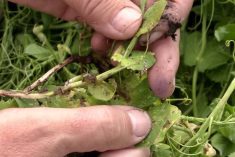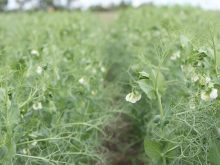Multi-tasking products | Companies use multiple active ingredients and combine them to develop a better product
Many of the new fungicides reaching the Canadian marketplace are group projects rather than solo acts.
While two of the new options feature new chemistries, a developing trend is to combine two modes of action, or active ingredients, into one product.
BASF announced this winter that it had registered Twinline, a broad spectrum fungicide for disease control in cereals, which contains a Group 11 strobilurin and a Group 3 triazole.
And last month, Mana, the world’s largest off-patent manufacturer of agrochemicals, announced the Canadian registration of Blanket AP, its version of the popular Quilt fungicide. Blanket AP uses the active ingredients propiconazole and azoxystrobin, groups 3 and 11 re-spectively.
Read Also

Fendt takes a combine on the road in the U.S.
Putting an Ideal combine in fields across different regions has given the brand a chance to prove that the combine is capable of performing well in a variety of conditions.
Philip Somerville, Mana Canada’s new product development manager, said growers should expect to see more products in the marketplace with multiple modes of action.
“As new products come on the market, like a brand new AI (active ingredient) and they have a patent life, chances are you may see an individual product on the market for the life of the patent,” he said.
However, if the new active ingredient has a few holes in its disease control, crop protection companies may add another chemistry so that it is more effective against a broad spectrum of diseases.
“Two modes of action are better for broader disease spectrum (control)…. A lot of times there are synergies between the two AIs,” Somerville said.
“Both products have activity on that organism … but together they do a better job, so you get better efficacy.”
Resistance management is another benefit of this approach.
“I can’t speak to the industry as a whole … (but) we’re going to be bringing new products that are multiple mode of action products, to continue the sustainable use of fungicides,” he said.
“I think what we’ve learned from herbicides is that chemistry resistance is a risk on any farm. So we feel it’s important to have a sustainable approach.”
Resistance to fungicides that have multiple modes of action would develop more slowly because resistance occurs when there’s a mutation in the pathogen, said Holly Derksen, Manitoba Agriculture plant pathologist.
“When you’re using a dual mode, there has to be two mutations. So the risk goes down (based on) common sense. The mutation has to happen twice.”
The new products should retard the development of resistant disease strains, but that doesn’t mean growers can repeatedly use the same product. Producers need to adopt a variety of strategies to combat resistance, Derksen said.
“Ideally, you should be using dual mode fungicides, you should also be rotating your fungicide, reducing the number of applications per season and only applying when necessary.”
Somerville said two types of products use dual modes of action: pre-mixed products, where both active ingredients are sold in one jug, and co-packs, where the two active ingredients are packaged separately in the box.
Blanket AP is a co-pack, but the company is developing a pre-mix.
An important distinction between co-packs and pre-mix fungicides is that companies can get a new patent on pre-mixes. As a result, companies can use off-patent active ingredients and combine them to develop a new product with a new patent.
“If it’s a co-pack, you can put product A and product B in a case together, but usually you have to get approval from another company,” Somerville said.
However, he said companies have spent money and time developing and testing the efficacy of the combination product, so there are reasons for a patent on a pre-mixed product with two active ingredients.
“A company does the testing and develops a pre-mix. It’s also a convenience thing for the farmer.”
Meanwhile, Dupont has registered a product that will help sunflower growers deal with sclerotinia.
Vertisan is a Group 7 chemistry that will protect canola, pulse crops and sunflowers.
“Both Vertisan and Lance are registered this year for sclerotinia in sunflowers,” Derksen said.
“Previous to this year, sunflowers growers didn’t have a fungicide option for sclerotinia.”
















